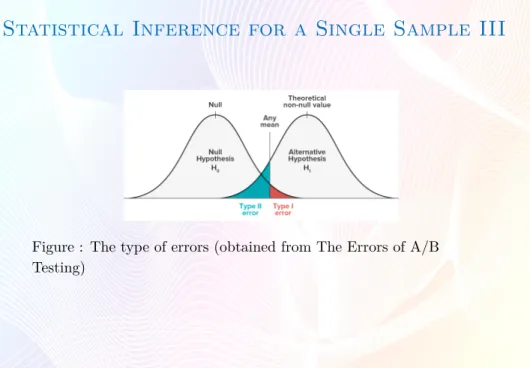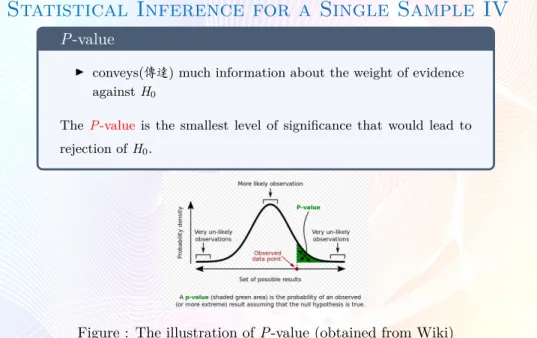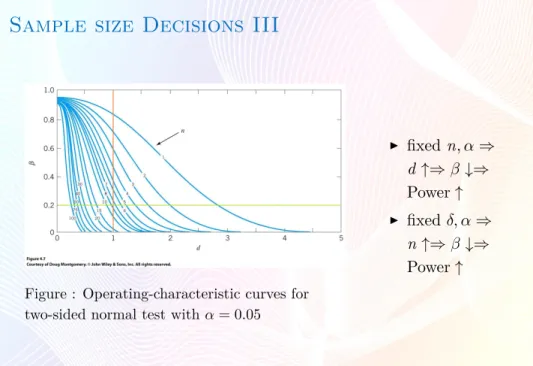Chapter 4
Statistical Inference in Quality Control and Improvement
許湘伶
Statistical Quality Control (D. C. Montgomery)
Sampling distribution I
I a random sample of size n: if it is selected so that the observations {xi} are i.i.d.
I x¯: central tendency
Sampling from a Normal Distribution I
I x ∼N(µ, σ2) I x1, . . . ,xn is sampled from N(µ, σ2) ⇒¯x= Pn i=1xi n ∼N(µ, σ2 n ) I x1, . . . ,xn i.∼i.dN(0,1) y= n X i=1 xi2∼χ2n (Γ(n 2,2)) f(y) = y n/2−1e−y/2 Γ(n/2)2n/2 , y >0 E(y) =n Var(y) = 2nSampling from a Normal Distribution II
I x1, . . . ,xn ∼N(µ, σ2) y= Pn i=1(xi−x¯)2 σ2 = (n−1)s2 σ2 ! ∼χ2n−1Sampling from a Normal Distribution III
I x ∼N(0,1), y ∼χ2k and x ⊥y t = qxy k ∼tk f(t) = Γ ((√ k+ 1)/2) kπΓ(k/2) t2 k + 1 !−(k+1)/2 , −∞<t <∞ E(t) = 0, Var(t) = k k−2, fork>2Sampling from a Normal Distribution IV
I k→ ∞ ⇒ thet distribution is closely approximate N(0,1)
I Generallyk >30 I x1, . . . ,xn ∼N(µ, σ2) I ¯x∼N(µ,σn2) I (n−1)s 2 σ2 ∼χ 2 n−1 I ¯x⊥s2 ¯ x−µ s/√n ∼tn−1
Sampling from a Normal Distribution V
I w ∼χ2u,y ∼χ2v, and w⊥y Fu,v = w/u y/v ∼Fu,v I x ∼Fu,v f(x) = Γu+2v uvu/2 Γ u2 Γ v2 xu/2−1 u v x+ 1(u+v)/2 0<x<∞Sampling from a Normal Distribution VI
I x11, . . . ,x1n1 ∼N(µ1, σ12), I x21, . . . ,x2n2 ∼N(µ2, σ22) I (ni−1)s 2 i σ2 i ∼χni−1, i = 1,2 s12/σ21 s22/σ22 ∼Fn1−1,n2−1Sampling from a Bernoulli Distribution I
I x ∼ Ber(p) (p: the probability of success)
p(x) = ( p, x= 1 (1−p), x= 0 I x1, . . . ,xn ∼ Ber(p) x = n X i=1 xi ∼ B(n,p) I E(¯x) =p, Var(¯x) = p(1n−p)
Sampling from a Poisson Distribution I
I x1, . . . ,xm ∼ P(λ) x= n X i=1 xi ∼ P(nλ) I E(¯x) =λ, Var(¯x) = λnI Linear combinations of Poisson r.v. are used in quality engineering work
I xi i.∼ Pi.d (λi),i = 1, . . . ,m, {ai}: constants I m different types of defects
I The distribution of L=Pmi=1aixi is not Poission unless all ai=1
Point Estimation of Process Parameters I
I Statistical quality control: the probability distribution isused to describe or model some critical-to-quality(關鍵質量
要素) control
I The parameters of the probability distributions are generally unknown
I A point estimator: a statistic that produces a single numerical value as the estimate of the unknown parameter Distribution Population parameter sample estimate
N(µ, σ2) µ ¯x N(µ, σ2) σ2 s2
P(λ) λ ¯x
Point Estimation of Process Parameters II
Properties
Important properties are required of good point estima-tors: 1. Unbiased: E(ˆθ) =θ 2. Minimum variance I E(¯x) =µ I Var(s2) =σ2 I E(s) =c4σ = 2 n−1 1/2 Γ(n/2) Γ((n−2)/2)σ ⇒E s c4 =σ
Point Estimation of Process Parameters III
I Range method: to estimate the standard deviation
I x1. . . ,xn ∼N(µ, σ2)
The range sample: R= max
1≤i≤n(xi)−1≤mini≤n(xi) =xmax−xmin I The relative range: W = Rσ
E(W) =d2 (d2 : Appendix Table VI (2≤n≤25))
⇒ˆσ= R
Statistical Inference for a Single Sample I
I Techniques of statistical inference:I parameter estimation I hypothesis testing
I Statistical hypothesis: a statement about the values of the parameters of a probability distribution
Testing a hypothesis
I Null hypothesis (H0) and alternative hypothesis (H1)
I Testing statistics
I Type of errors
I Critical region (or rejection region)
I Reject of fail to reject theH0 I Confidence interval
Statistical Inference for a Single Sample II
Type of errors
Hypothesis
H0is true H1is true Fail to rejectH0 Correct Decision Type II error (β)
RejectH0 Type I error (α) Correct Decision (1−β=Power)
α=P{type I error}=P{rejectH0|H0 is true} (producer’s risk) β=P{type II error}=P{fail to rejectH0|H0is false} (consumer’s risk) Power = 1−β=P{rejectH0|H0 is false}
Statistical Inference for a Single Sample III
Figure : The type of errors (obtained from The Errors of A/B Testing)
Statistical Inference for a Single Sample IV
P-valueI conveys(傳達) much information about the weight of evidence againstH0
TheP-valueis the smallest level of significance that would lead to rejection ofH0.
Statistical Inference for a Single Sample V
I Confidence interval (C.I.):Ex: Two-sided 100(1−α)% C.I.
construct an interval estimator of the meanµ
P{L≤µ≤U}= 1−α
100(1−α)% C.I. of µ: L ≤µ≤U
I One-sided lower 100(1−α)% C.I. : P{L≤µ}= 1−α
L ≤µ
I One-sided upper 100(1−α)% C.I. : P{µ≤U}= 1−α
Statistical Inference for a Single Sample VI
Hypothesis testing for a single sample:
I Inference on µ: variance knownorvariance unknown I Inference on σ2
I Inference on p (population proportion)
Statistical Inference for a Single Sample VII
Inference Sided Hypothesis Testing statistics Critical region 100(1−α)% C.I.
µ(σknown) Two-sided H0:µ=µ0 H1:µ6=µ0 Z0=x−µ¯ 0 σ/√n |Z0|>Zα/2 ¯x−Zα/2√σ n≤µ≤¯x+Zα/2 σ √ n One-sided H0:µ=µ0 H1:µ > µ0 Z0>Zα x¯−Zα/2√σ n≤µ H0:µ=µ0 H1:µ < µ0 Z0<−Zα x¯+Zα/2√σ n≥µ µ(σunknown) Two-sided H0:µ=µ0 H1:µ6=µ0 t0=¯x−µ0 s/√n |t0|>tα/2,n−1 x¯−tα/2,n−1√s n≤µ≤¯x+tα/2,n−1 s √ n One-sided H0:µ=µ0 H1:µ > µ0 t0>tα,n−1 x¯−tα,n−1√s n≤µ H0:µ=µ0 H1:µ < µ0 t0<−tα,n−1 x¯+tα,n−1√s n≥µ I z ∼N(0,1)⇒P(z>Zα/2) =α/2 I t ∼tn−1⇒P(t>tα/2,n−1) =α/2
Statistical Inference for a Single Sample VIII
Test the hypothesis: the varianceof a normal distribution equals a constant
Inference Sided Hypothesis Testing statistics Critical region 100(1−α)% C.I.
σ Two-sided H0:σ=σ0 H1:σ6=σ0 χ2 0=(n−1)s 2 σ2 0 χ2 0> χ2α/2,n−1or χ2 0< χ21−α/2,n−1 (n−1)s2 χ2 α/2,n−1 ≤σ2≤ (n−1)s2 χ2 1−α/2,n−1 One-sided H0:σ=σ0 H1:σ > σ0 χ2 0< χ21−α,n−1 σ2≤ (n−1)s 2 χ2 1−α,n−1 H0:σ=σ0 H1:σ < σ0 χ2 0> χ2α,n−1 (n−1)s 2 χ2 α,n−1 ≤σ2 I P(χ2n−1>χ2α/2) =α/2 andP(χ2n−1>χ21−α/2) = 1−α/2
Statistical Inference for a Single Sample IX
Test the hypothesis: the proportionp of a population equals a standard value (p0)
I a random sample of n items is taken from the population
I x items in the sample belong to the class associated withp
I 二項分佈趨近至常態分佈
Inference Sided Hypothesis Testing statistics Critical region 100(1−α)% C.I. p Two-sided H0:p=p0 H1:p6=p0 Z0= (x+0.5)−np0 √ np0(1−p0) ifx<np0 (x−0.5)−np0 √ np0(1−p0) ifx>np0 |Z0|>Zα/2 ˆp−Zα/2 q ˆ p(1−ˆp) n ≤p≤ˆp+Zα/2 q ˆ p(1−ˆp) n I pˆ= xn
Statistical Inference for a Single Sample X
I n is large,p≥0.1⇒ the normal approximation to the binomial can be used
I n is small⇒ the binomial distribution ⇒C.I.
I n is large,p is small⇒ the Poisson distribution
Sample size Decisions I
I Probability of type II errorH0 :µ=µ0 vs. H1 :µ6=µ0 ⇒Z0 = ¯x−µ0 σ/√n ∼N(0,1) I Supposeµ1 =µ+δ, δ >0 (Under H1) Z0= x¯−µ0 σ/√n ∼N( δ√n σ ,1)
I The type II error:
β = Φ Zα/2−δ √ n σ ! −Φ −Zα/2− δ √ n σ !
Sample size Decisions II
I β is a function of n, δ, α
I Specify α and design a test procedure maximize the power (⇒minimizeβ, a function of sample size.)
I Operating-characteristic (OC) curves(操作特性曲線):
Sample size Decisions III
Figure : Operating-characteristic curves for two-sided normal test with α= 0.05
I fixedn, α⇒ d ↑⇒β ↓⇒ Power↑ I fixedδ, α⇒ n↑⇒β↓⇒ Power↑
Sample size Decisions IV
> library(pwr)
> pwr.t.test(n=25,d=0.75,sig.level=.01,alternative="greater",type ="one.sample")
One-sample t test power calculation
n = 25 d = 0.75 sig.level = 0.01 power = 0.8865127 alternative = greater > pwr.t.test(d=0.1/0.1,sig.level=0.05,power=0.85,type ="one.sample")
One-sample t test power calculation
n = 11.06276 d = 1 sig.level = 0.05
power = 0.85 alternative = two.sided
Inference for two samples I
I Inference for a difference inMeans: variance known or variance unknown
I Inference on the variances of two normal distributions
Inference for two samples II
I E(¯x1−¯x2) =µ1−µ2 I Var(¯x1−¯x2) = σ 2 1 n1 + σ2 2 n2 I The quantity: Z = ¯x1−rx¯2−(µ1−µ2) σ2 1 n1 + σ2 2 n2 ∼N(0,1)Inference for two samples IV
Case 1:
σ2
1 =σ22=σ2 when variances unknown
I E(¯x1−x¯2) =µ1−µ2
I Var(¯x1−x¯2) =σ2n11 +n21
I Thepooled estimator ofσ2
sp2= (n1−1)s2 1+ (n2−1)s22 n1+n2−2 =ws 2 1+(1−w)s 2 2 (weighted average) I t test statistic: t = x¯1−¯x2−(µ1−µ2) spqn11 + n21 ∼tn1+n2−2
Inference for two samples VI
Case 2:
σ126=σ22 when variances unknown
I The test statistic:
t0∗ =x¯1−rx¯2−(µ1−µ2) s12 n1 + s22 n2 ∼tν, ν = s2 1 n1 + s2 2 n2 2 (s2 1/n1)2 n1−1 + (s2 2/n2)2 n2−1 −2
Inference for two samples VII
Paired data
I dj =x1j−x2j,j = 1, . . . ,n I Hypothesis:
H0 :µd= 0⇔H0 :µ1 =µ2
I Thet test statistic:
t0= ¯
d
sd/√n ∼tn−1 I RejectH0 if|t0|>tα/2,n−1


